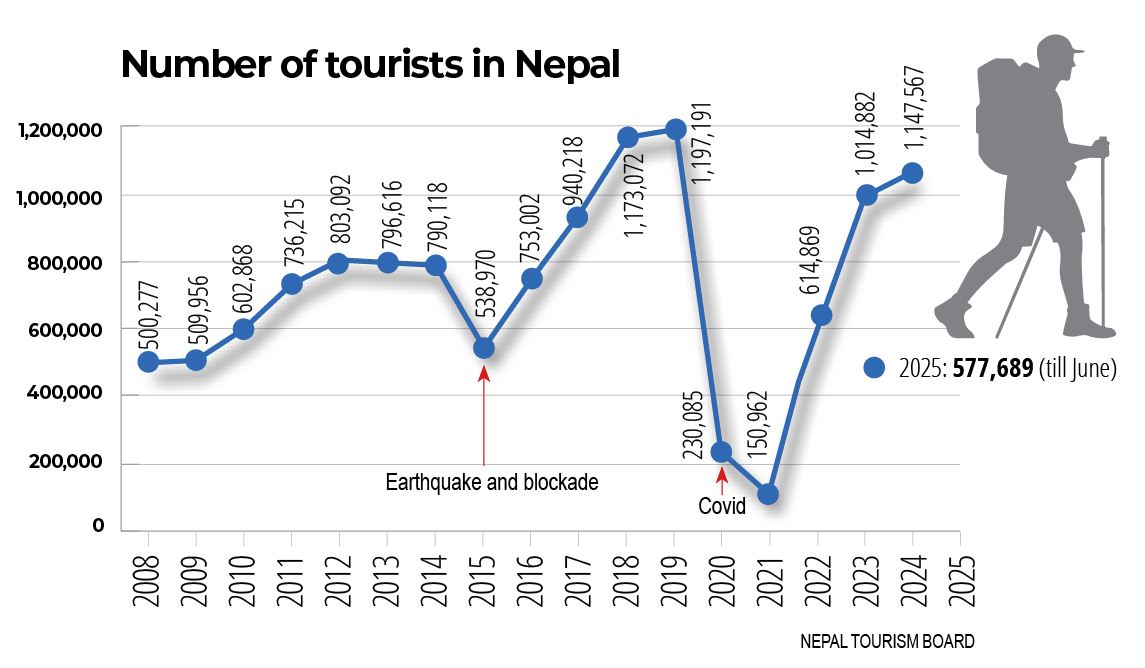Tourism needs a new push
Visitors are coming to Nepal organically, the industry needs a more deliberate pushDoes anyone know that 2023-33 was declared the Visit Nepal Decade? Or that Pokhara announced that 2025 is a Special Tourism Year? The fuselage of Nepal Airlines jets still carry the Visit Nepal Year 2020 logos.
Such ad hoc and unnoticed promotion is emblematic of the way Nepal has tried to increase visitor arrivals post-Covid — and of the country’s wider political disarray.
Deepak Raj Joshi of the Nepal Tourism Board (NTB) has his work cut out to coordinate various agencies of the government to boost arrivals.
He says, “We have been working on marketing strategies to revive the tourism sector, and are hopeful that this year will mark a 8-10% increase in arrivals compared to the pre-pandemic times.”
On paper, tourist numbers have rebounded to pre-Covid numbers with over 1 million last year, but official figures do not give a true picture of duration of stay, average spending, and the fact every visitor is counted as a ‘tourist’, even repeat visitors who come on business.
The few bright spots are largely a result of private sector promotion of niche tourism products, individual social media posts of adventurous treks in Nepal, or the fact that Indians are allowed to enter China again to visit Lake Mansarovar and Mt Kailash via Nepal.
Indeed, Simkot airport has up to 15 flights a day from Nepalganj bringing in Indian pilgrims who are then ferried by helicopter to the border in Hilsa, or Lapcha Pass from where the holy sites in Tibet are visible. The rudimentary hotels and rest houses along the route in Humla have been bursting at the seams for the past month, to the point that some establishments are no longer able to provide patrons basic amenities.
Last year, 1.14 million tourists visited Nepal, and the government has projected up to 10% increase in tourist arrivals this year. International tourist arrivals to Nepal have been steadily increasing, especially from the US, Europe, and India. Domestic and regional travel has also increased after the Covid lockdowns.

The tourism industry employs at least 1 million people, trekking injects money directly into the rural economy and sustains ancillary sectors like handicrafts and domestic aviation. In the last fiscal year, tourism brought in Rs82.33 billion, according to Nepal Rastra Bank. But the industry has been affected by negative publicity about poor infrastructure, air pollution in Kathmandu, travel safety and news of disasters like the China-Nepal flood last week that made international headlines. Growing worries about the climate crisis is also affecting youth travel, especially from Europe.
Read also: Missing out on Nepal’s tourism potential
“The limitations of airport and road infrastructure has hindered the development of the tourism sector,” admits Joshi. “And many are put off by the appalling state of our road network, especially during the monsoon season.”
Nepal is home to 20 protected areas, 10 heritage sites, and eight out of the world’s 10 highest mountains, and despite all the obstacles it is still the perfect destination for the modern social media savvy traveller, who are experience-driven and inclined to look for itineraries that emphasise wellness and cultural immersion.
Some hotels around Kathmandu, Pokhara, Jomsom and the Khumbu have strived to adapt to this new tourism landscape, expanding facilities with significant international investment.
Luxury hotels like Aloft Kathmandu in Thamel were inaugurated just before the pandemic lockdowns, survived the crisis and thrived as it. Says General Manager Vikram Singh (pictured, below): “Our prime location in Thamel enhances the guest experience, especially for those seeking convenience and immersion in the local scene and travellers who want to be in the centre of it all.”

Sustainability and environmental consciousness has also become an integral part of the hospitality industry. ISO certifications as well as sustainability initiatives like the Travelife sustainability certification for eco-friendly resorts validate credibility of hotels.
Aloft is the first five-star hotel in Nepal to have earned the Waste Smart Certificate, and it has also been awarded the ISO 14001:2015 certification, which is the internationally recognised standard for environmental management systems (EMS).
But such investments will not amount to much unless Nepal makes serious efforts to promote itself as a tourism destination, especially to its two giant neighbours. More importantly, the country needs to increase activities in which tourists can spend the money they want to. “While mountaineering and adventure tourism are extensively promoted, we have fallen short of marketing other elements such as wildlife, pilgrimage and cultural heritage,” says Joshi. “There is a need to diversify promotion to increase income from the tourism sector.”
Meanwhile, making Nepal more accessible to international and domestic visitors, must also be a priority. Kathmandu remains the sole aerial gateway despite new airports in Pokhara and Bhairawa.
“International airlines have shown interest, and if access and flights are increased these airports can be fully functional,” says Joshi. But Sichuan Airlines has stopped flying to Pokhara, and there does not seem to be much interest from Thai, Vietnamese and Cambodian carriers to fly directly to Lumbini.
Says Singh: “There’s tremendous opportunity to strengthen Nepal’s destination marketing by telling richer, more compelling stories that connect travellers with our culture, nature, and people.”




